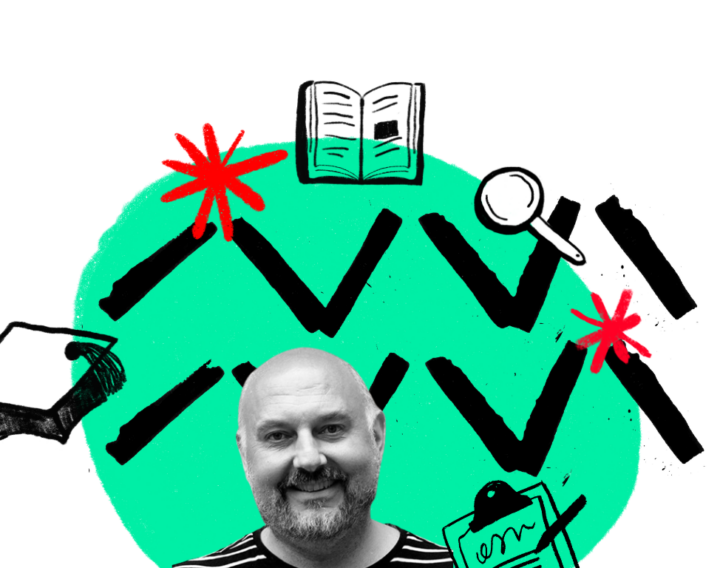
Show us your messy bits
Snook Spotlight Series
Snook Spotlight Series

In this edition of the Spotlight series, Kat Dixon talks to Snook’s Service Designers Olivia Holbrook and Tom White about the chaos and complexity of service design projects, which they often refer to as the messy bit.
Kat: I overheard you two talking about how service designers love mess. You said that in service design, if we’re not working in mess, we’re not doing our jobs. Why do you think service designers love mess?
Olivia: There’s something in the brain of designers that likes seeing patterns, seeing things that don’t work, seeing the impact of that and wanting to fix it. We love seeing the mess and getting stuck into it. Fundamentally, if there was no mess, we wouldn’t be needed.
Fundamentally, if there was no mess, we wouldn’t be needed.
Olivia: Also, mess creates connection. When you name a mess, and you start to “mess in a mess”, you definitely bring people together.
Kat: What about you, Tom?
Tom: For many designers there’s an idea of bringing order, or at least a perception of structure, to something messy. A lot of service design is about sequencing and structuring so people can start to see the big picture and decide how and where to act.
We make mess accessible to people who are trying to make sense of it.
I love service design because you get to be a detective. You roll your sleeves up. And there’s a disruptive element to it, we’re in there to shake things up.
Donald A. Schoen has a great book ‘The Reflective Practitioner’. In it he talks about the idea of ‘technical practice’ – where we stand at the top of the hill, away from the danger, with our head in the clouds, in safety, where the easy decisions are. And then we have ‘reflective practice’. Where we intentionally spend time at the bottom of the hill, in the murky swamp trying to pick through it all.
The thing is, we flick between the two mindsets – we often need both types of thinking, but it’s reflective practice where we really get our hands dirty and understand the big complex stuff.
I think there’s something lovely in that; this project will be painful and messy and sometimes, it won’t be fun. But, ultimately, there’s value in that.
Kat: I’ve found facing a big mess overwhelming in the past. I get excited, great, we’re going to solve this problem. Then I lay it all out on sticky notes and think, yikes, this problem is huge. Do you think service designers are less scared of mess than the average person?
Olivia: The more service design you do, the more you learn to trust yourself and build a good instinct. You see the size of mess, and its overwhelming, but it’s easier to think ‘look, I’ve been here before and I got somewhere really useful out of it’ than it is to focus on ambiguity of it all.
You do learn to trust the process. No good has ever been done by avoiding mess. Skirting around it only makes the symptoms worse.
No good has ever been done by avoiding mess. Skirting around it only makes the symptoms worse.
Tom: I’m never not scared of it. You have to be deliberate, acknowledge that the twists and turns are part of it.
I’m never at ease with it. But I also think that the day I am completely at ease means maybe I don’t care anymore, and that terrifies me more.
It’s electrifying. Sometimes you need to find your entry point to jump in and, like Olivia says, trust that your process will take you places.
That’s also the value of having good teams around you; it means you’re not carrying all that emotional load yourself. That’s when you can start to take more risks.
Kat: Is there good mess and bad mess?
Olivia: Mess is complexity. And if a problem doesn’t seem complex, you’re not looking at it hard enough.
There’s good complexity, as in how things need to work together to accommodate different people and needs.
And there’s bad complexity, which we often call a Frankenstein. Like when a service over time has had things added on, shortcuts, workarounds and you have something that doesn’t connect in a useful or logical way, it’s just surviving.
Tom: It’s the distinction between complex and complicated. The cliche of complicated is a well-oiled machine. There’s lots going on, but every part is interdependent and there for a reason. There is a fluency to it, a flow, which feels good. Complexity feels knotty and frustrating and hard to articulate.
Olivia: Good mess is nuanced. If you go into a project with the idea of trying to clean up a mess, you’ll quickly realise that’s not what needs to happen.
You need to be in mess. You can simplify it, but you can’t clean it.
You need to be in mess. You can simplify it, but you can’t clean it.
Tom: There’s a trend towards concealing mess.
It used to be that objects told the stories of their makers. With an old chair, you could see where it had been nailed, brush marks from the varnish.
Now, products are designed to look like they just appeared by magic. You maybe see a few injection moulding seams, but that’s it. Pick up your phone and it’s a poetic object; there’s no sign of the maker in there.
I think service design is going through a similar evolution. The default position is to make the creation of services as invisible as possible, offer a ‘seamless’ user experience.
I’m becoming increasingly suspicious of services where you have no sense of how it came into being or who made it, or who participates in its delivery. They’re concealing their messiness. There’s often an aspiration to make services as clinical as possible. In lots of cases that works, but in other cases the mess and apparent inefficiency is the thing that makes it more personable and memorable.
Cameron Tonkinwise talks about the ‘line of concealment’, the line that separates the front and backstage. Users sometimes like to peak behind the curtain – it can make services more authentic, more meaningful and memorable.
This is true in human relationships. We wear masks and conceal our messiness. But actually, when you get to know someone, it’s often their messy bits that are the things you connect over.
We need to celebrate mess.
The quicker we make peace with mess, the easier it is to have authentic, meaningful conversations. I want to cut through the shit and get to the mess.
The quicker we make peace with mess, the easier it is to have authentic, meaningful conversations. I want to cut through the shit and get to the mess.
Kat: I love this idea of messiness being what makes us human. I’ve always thought of a seamless user experience as being one where you can’t see the join between steps, but seamless can also mean hiding the backstage.
And also, your point of not cleaning the mess. It’s like you’re saying, we can’t fix humanness. Perhaps learning to inhabit the discomfort of mess is part of being a good service designer.
Olivia: I’ve noticed there seems to be a common agreement that efficient or good services are transactional; people get in and out, and they’re done.
But most transactional services with relational elements are going to be more impactful.
Most of the discoveries I’ve worked on, the research gives similar principles; “I just want better communication”…“I just want to understand.” So much of good design is about managing expectations and trust.
Trying to clean up a mess is like trying to remove that relational element, but that humanness is pretty much the foundation of any service.
Kat: You’ve both been working in service design for some time. If you were speaking to your former self about mess, what advice would you give yourself?
Tom: There’s a really nice quote; “It’s impossible to understand the entirety of the system in which you’re stood.” I find this quite calming. We can go in, do research, map systems, create journeys, but you never get the entirety of perspectives and perceptions.
It’s a helpful dose of reality to know that whenever you’re designing a service, you’re never stood on a constant platform. There are always tides of change.
It’s a helpful dose of reality to know that whenever you’re designing a service, you’re never stood on a constant platform. There are always tides of change.
The sooner you accept that, the quicker you’ll get to sleep at night. And that’s coming from someone who has had a lot of sleepless nights over these things!
Also, I wish I’d been more courageous. I wished I’d challenged a few more people earlier in my career. If I were to look back on anything, it would be to stop being so conscientious around the kinds of powers that are in those spaces. Because sometimes, they need to hear tough lessons.
Olivia: A hard lesson I’ve learned is that you can’t know and understand everything. You need to know enough to know how to move forward.
I’ve learned how not to be paralysed by the overwhelm. The more I’ve done, the more experience I’ve got, the more I’ve trusted my brain. I know now that if it’s important, it’ll stick.
My advice is learn to be comfortable in the discomfort and ambiguity of mess.
My advice is learn to be comfortable in the discomfort and ambiguity of mess.
Don’t get sucked in by those feelings of despair. “It’s too much. We’ll never figure it out.” Sit with that.
Also, push the boundaries. I like to preach a bit of anarchy. I prefer flat structures, but where there are hierarchies, don’t be afraid to shine a light up to the messy parts.
Show that mess with the evidence you’ve gathered. That can be quite powerful.
Doing that can help you find your voice as a designer early on.
Kat: Tom and Olivia, thank you for sharing your messy bits. You’ve been great.
If you’d like to talk to Snook about any themes covered in this article, say hello at curious@wearesnook.com.